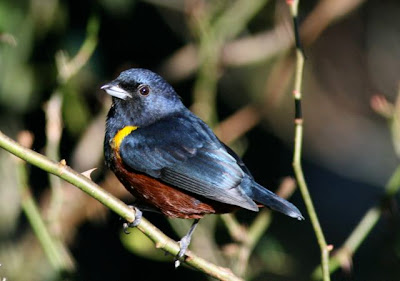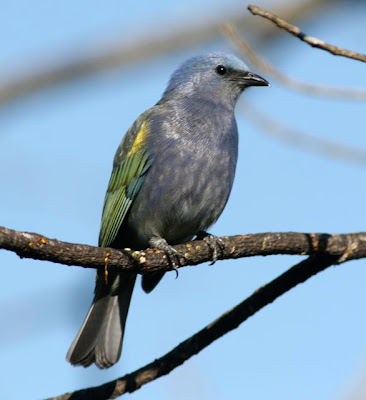We arrived at our hotel, Hotel Ypé, in Itatiaia National Park in the afternoon. On the long bumpy road up to the hotel we had glimpses of zipping hummingbirds and saw the lush jungle on all sides. The air got cooler and thinner as we ascended the mountains of the park. Clouds drifted past below us.
It felt great to climb out of the van at the hotel's main building and as we stretched our legs we noticed a whirlwind of activity at the feeders hanging over the building's veranda. Like moths to a flame, we wandered around the building for a better look. What we found was the most amazing tropical bird-feeding station I've ever seen. Six or seven hummingbird feeders attracted as many hummer species while three separate hanging dishes filled with cut fruit attracted tanagers, dacnises, bananaquits, caciques, and a super weird-looking woodpecker.
I had to keep reaching up to close my jaw.
I wanted to use my camera and my binocs at the same time...
Then it was time to go find our rooms. This was agonizing to have to leave the feeders, but I felt better once I saw my room. Why? Because this is the view I had from my room's balcony:
Within minutes we were back looking at the feeders again, enjoying new life birds in quick succession, including Brazilian ruby, black jacobin, violet-crowned woodnymph, and scarlet-rumped cacique.
The birds that were most numerous at the fruit trays were the blue-naped chlorophonias. If there's a bird that does a better job of combining the colors of yellow, blue, and green in its plumage I have yet to see it. I probably snapped of 500 digital frames with my camera. The birds were so intent on feeding that we could approach within a few feet.
Nearby was another colorful bird, the more earth-toned chestnut-bellied euphonia. Chlorophonias and euphonias are tanager relatives, but they are smaller than what we think of as tanagers—they look more like buntings to me.
The larger tanagers were more shy. Among the most numerous were the yellow-chevroned tanagers—sky blue with a dab of yellow near the shoulder.
I could (and probably will) do complete posts just about the hummingbirds. There were so many individuals hovering and zipping and drinking and fighting around the feeders that it was difficult to watch any one individual for long. Any bird that stopped to drink was soon chased from the feeder by another hummer. Among the easily seen species were swallow-tailed hummingbird, Brazilian ruby, black jacobin, white-throated hummingbird, and violet-crowned woodnymph.
 Male white-throated hummingbird.
Male white-throated hummingbird.Male violet-crowned woodnymph at the Hotel Ypé feeders
And then it was time to leave again. Slowly the idea dawned on me that we were going to see a lot of birds on this trip, but that sitting around enjoying them at length was not always going to be possible. Off we went back down the road to the house of a woman named Norma. Tucked into the side of a dark valley, like the house of a forest sprite was Norma's place. The feeders were immediately restocked by our hostess and the birds began flooding in. The first new bird for us was the burnished-buff tanager, looking (color-wise at least) like the interbred offspring of a bobolink and a tree swallow.
We sat around on patio chairs while the birds chittered and flitted all around us. More woodnymphs, rubies, rufous-collared sparrows, euphonias and chlorophonias—peaceful and inspiring all at once.
We were here to see one very special bird—a tiny hummingbird called a coquette. To be more specific, we were waiting for the frilled coquette to make an appearance. According to Norma the bird came in close to dusk for a final feeding each day. We waited and glassed each bird arriving at the feeders.
While waiting I noticed an stone chapel next to Norma's house, with an old bell hanging in its stone steeple. The bell was green with corrosion—the same color as the forest around us. I wondered when the bell had tolled last.
Soon it was getting later and darker. In the tropics the sun is up from 6 to 6 each day then it beats a hasty retreat. As the light grew dimmer, my bird images became more and more blurred.
With night poised to pounce, we wondered if our coquette would show... I'll resume here tomorrow.





















7 comments:
What glorious birds. It is so nice of you to share your great experiences with us. Can't wait for another post.
It looks like someone smeared a box of melted Crayola crayons! Very cool.
It just doesn't seem quite fair that Brasil gets all those little jewels. To live where chlorophonias are common, now that would be a fine, fine thing. This could have been three posts, Blogzilla. I know it's not your style to blog about ancient history, but I'm just sayin'. It works OK for the BlogAnt.
Wow! What absolutely gorgeous colors!! Those chlorophonias look like candy and I can't get over the blue of the dacnis. The hot electric pink hotel seems to fit right in, but I have one very serious question:
HOW do you know what color Barbie's toenails are? Doesn't seem like something a Hot Dog Brother should be so familiar with.
Enquiring minds want to know...
~Kathi, who can't wait for the teasing coquette
Oh the color! Oh the gem sparkling beauty! I just simply can't imagine being close to any of these exquisite birds, let alone watching them casually feed in front of me on a veranda. And, and, and???
I loooooooooove hummingbirds!!
I'm officially jealous :P
WOW, all those amazing colors!! Are those birds there like that year round?
Post a Comment